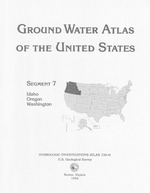Ground Water Atlas of the United States: Segment 7, Idaho, Oregon, Washington
Links
- More information: USGS Index Page (html)
- Document: Report (65.98 MB pdf)
- Larger Work: This publication is Chapter H of Ground Water Atlas of the United States
- Download citation as: RIS | Dublin Core
Abstract
The States of Idaho, Oregon, and Washington, which total 248,730 square miles, compose Segment 7 of this Atlas. The area is geologically and topographically diverse and contains a wealth of scenic beauty, natural resources, and ground and surface water that generally are suitable for all uses. Most of the area of Segment 7 is drained by the Columbia River, its tributaries, and other streams that discharge to the Pacific Ocean. Exceptions are those streams that flow to closed basins in southeastern Oregon and northern Nevada and to the Great Salt Lake in northern Utah. The Columbia River is one of the largest rivers in the Nation. The downstream reach of the Columbia River forms most of the border between Oregon and Washington. In 1990, Idaho, Oregon, and Washington had populations of 1.0 million, 2.8 million, and 4.9 million, respectively. The more densely populated parts are in lowland areas and stream valleys. Many of the mountains, the deserts, and the upland areas of Idaho, Oregon, and Washington lack major population centers. Large areas of Idaho and Oregon are uninhabited and are mostly public land (fig. 1) where extensive ground-water development is restricted.
Surface water is abundant in Idaho, Oregon, and Washington, though not always available when and where needed. In some places, surface water provides much of the water used for public-supply, domestic and commercial, agricultural (primarily irrigation and livestock watering), and industrial purposes. In arid parts of Segment 7, however, surface water has long been fully appropriated, chiefly for irrigation. Ground water is used when and where surface-water supplies are lacking.
Ground water is commonly available to shallow wells that are completed in unconsolidated-deposit aquifers that consist primarily of sand and gravel but contain variable quantities of clay and silt. Many large-yield public-supply and irrigation wells and thousands of domestic wells are completed in these types of aquifers, generally in areas of privately owned land (fig. 1). In many places, deeper wells produce water from underlying volcanic rocks, usually basalt.
Most irrigation (fig. 2) is on lowlands next to streams and on adjacent terraces. Generally, lowlands within a few miles of a main stream are irrigated with surface water diverted by gravity flow from the main stream or a reservoir and distributed through a system of canals and ditches. In some areas, water is pumped to irrigate lands farther from the stream at a higher altitude. Along the Snake and Columbia Rivers, large pumping systems withdraw billions of gallons of water per day from the rivers to irrigate adjacent uplands that are more than 500 feet higher than the rivers. Elsewhere, irrigation water is obtained from large-capacity wells, where depth to water might exceed 500 feet below land surface.
Aquifers in Idaho, Oregon, and Washington, as in most other States, differ considerably in thickness and permeability, and well yields differ accordingly. Ground-water levels in a few areas have declined as a result of withdrawals by wells. State governments have taken steps to alleviate declines in some areas by enacting programs that either limit the number of additional wells that can be completed in a particular aquifer (Ground-Water Management Area) or prevent further ground-water development (Critical Ground-Water Area).
Segment 7 includes some of the driest parts of the Nation, as well as some of the wettest. Average annual precipitation (1951-80) ranges from less than 10 inches in arid parts of Idaho, Oregon, and Washington to more than 80 inches in the western parts of Oregon and Washington (fig. 3). Most storms generally move eastward through the area. The eastward-moving air absorbs the moisture that evaporates from the Pacific Ocean. As this air encounters the fronts of mountain ranges, it rises, cools, and condenses. Accordingly, the western sides of the mountain ranges receive the most precipitation. Much of the annual precipitation moves directly to streams as overland runoff. Some of the precipitation is returned to the atmosphere by evapotranspiration, which is the combination of evaporation from the surface and transpiration from the plants. A small part of the precipitation infiltrates the soil and percolates downward to recharge underlying aquifers.
Average annual runoff ( 1951-80) in the segment varies considerably (fig. 4), and the distribution of the runoff generally parallels that of precipitation. In the arid and the semiarid parts of Segment 7, most precipitation replenishes soil moisture, evaporates, or is transpired by vegetation. Little is left to maintain streamflow or to recharge aquifers. In the wetter parts, much of the precipitation runs off the land surface to maintain streamflow, and because evaporation is usually less in wetter areas, more water is available to recharge aquifers. Precipitation that falls as snow generally does not become runoff until spring thaws begin. Reservoirs constructed on major streams to mitigate flooding and to store water for irrigation, hydroelectric-power generation, and recreation also affect the timing of runoff. The runoff is stored and subsequently released during drier periods to maintain downstream flow.
Study Area
| Publication type | Report |
|---|---|
| Publication Subtype | USGS Numbered Series |
| Title | Ground Water Atlas of the United States: Segment 7, Idaho, Oregon, Washington |
| Series title | Hydrologic Atlas |
| Series number | 730 |
| Chapter | H |
| ISBN | 060776757X |
| DOI | 10.3133/ha730H |
| Year Published | 1994 |
| Language | English |
| Publisher | U.S. Geological Survey |
| Contributing office(s) | Oregon Water Science Center |
| Description | 31 p. |
| Larger Work Title | Ground Water Atlas of the United States |
| First page | H1 |
| Last page | H31 |
| Country | United States |
| State | Idaho, Oregon, Washington |


